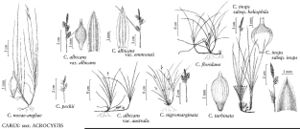Carex peckii
Rep. (Annual) Regents Univ. State New York New York State Mus. 47: 166. 1894.
Plants loosely cespitose; rhizomes ascending, reddish-brown, 0–15 (–30) mm, slender. Culms 21–47 cm, smooth to weakly scabrous distally; bases not fibrous. Leaf-blades pale green, shorter than culms, 1–3.3 mm wide, herbaceous, papillose abaxially, scabrous adaxially. Inflorescences with both staminate and pistillate spikes; peduncles of staminate spikes 0.4–2.2 mm; proximal cauline bracts leaflike usually shorter than inflorescences. Spikes: proximal pistillate spikes 2–3 (basal spikes 0); cauline spikes with proximal 2 spikes overlapping, se!parated by less than 7 mm, with 3–10 perigynia; staminate spikes 5.3–8.6 × 0.8–1.7 mm. Scales: pistillate scales reddish-brown to pale-brown, with broad white margins, ovate, 2.2–3.2 × 1.2–1.8 mm, 1/2 to 2/3 length of perigynia, apex acute to acuminate,; staminate scales elliptic, 2.4–3.2 × 0.9–1.8 mm, apex acute. Anthers 1.4–1.5 mm. Perigynia light green, veinless, ellipsoid, 3.2–4.2 × 1.1–1.3 mm, longer than wide; beak straight, pale green, 0.7–1 mm, ciliate-serrulate, apical teeth 0.2–0.4 mm. Stigmas 3. Achenes brown, obovoid to ellipsoid, obtusely trigonous in cross-section, 1.9–2.4 × 1–1.3 mm. 2n = 36.
Phenology: Fruiting mid May–mid Jul.
Habitat: Mainly calcareous soils on dry to mesic slopes, in partial shade in rich, deciduous or mixed deciduous-coniferous, open woods, bases of slopes, or full sun on exposed outcrops
Elevation: 10–2000 m
Distribution

Alta., B.C., Man., N.B., N.S., Ont., Que., Sask., Alaska, Iowa, Maine, Mass., Mich., Minn., Nebr., N.H., N.Y., N.Dak., S.Dak., Vt., Wis., Wyo.
Discussion
Hybrids between Carex peckii and other members of the section have not been confirmed; occasional plants appear to combine its characteristics with those of other species, such as C. tonsa.
Selected References
None.
Lower Taxa
"shortened" is not a number.
